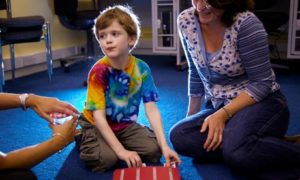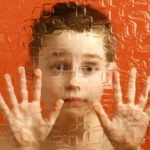 Autism Diagnosis:
Autism Diagnosis:
Differentiating Quirks from Disorders.
Autism and other branches of autism spectrum disorder can be difficult to diagnose since there is no particular autism test that can directly diagnose these disorders. Instead, an autism diagnosis depends on the careful evaluation of a child that is exhibiting unusual behaviors. These behaviors vary from playing with toys in repetitive ways to failing to make eye contact or respond to his or her name.
What Age is Autism Diagnosed At?
How autism is diagnosed depends on the age of the child, although autism diagnosis age can be as early as the age of 18 months. Signs and symptoms may appear as early as 6 to 12 months of age, but professionals are hesitant to make a diagnosis at that early due to the fact that many symptoms can either continue to emerge or fade away until the child is 24 months old.
Professionals strongly suggest that parents with children or toddlers displaying unusual behaviors should take a look at the M-CHAT (the Modified Checklist of Autism in Toddlers), which is a list of questions about their child. A few common questions asked during this test are:
• If you point to something across the room, does your child look at it?
• Does your child play pretend or make-believe?
• Does your child point with one finger to ask for something or to get help?
• Is your child interested in other children?
• Does your child respond when you call his or her name?
All of these questions ask about common symptoms of autism that children typically display during the early stages. Though this test is not a replacement for professional evaluation, the outcome can help you determine whether or not you need to take your child in for further assessment. From birth to 3 years old, all children should be screened for common developmental milestones. This way, doctors can determine whether or not the child is developing properly. If they are missing key milestones, they may need to be evaluated by someone more familiar with autism to determine whether or not the missed milestone may be an early symptom.

A common evaluation involves a handful of different types of doctors. Speech and language pathologists, pediatricians, psychologists, and occupational therapists team up to analyze every aspect of the child’s development and see where he or she is lacking. It’s important that other diagnoses are ruled out, such as ADHD, anxiety disorder, or even natural quirks that are not a cause of an underlying disorder. These professionals provide both behavioral assessments as well as physical assessments. They begin by documenting the child’s medical and developmental history, followed by more standard questionnaires, clinical observations, and intelligence tests. Physical exams are used to make sure the child is growing normally, and hearing exams are used to make sure the autistic traits aren’t the result of a different problem.
If a child is thought to be developing autism symptoms, they will be further screened by the Autism Diagnosis Interview – Revised (ADI-R). The ADI-R is an interview that contains over 100 questions.
It covers 4 main factors –
- repetitive behaviors
- communication,
- social interaction
- age-of-onset symptoms.
The Childhood Autism Rating Scale (CARS) is also commonly used, which evaluates the child’s ability to adapt to change, their body movements, listening response, verbal communication, and relationships with others. The child is then rated on a scale that determines how different their actions are in relation to other children of the same age. Beyond all of these tests and evaluations, the child in question should also be subject to a lead screening. Children affected with autism tend to have elevated levels of lead in their bloodstream, and can be the cause of children who are stuck in a stage where they put everything into their mouths (oral-motor stage).
Types of Autism
Since there are 5 distinct subtypes of autistic spectrum disorder, each one has their own diagnostic criteria that the child must fit in order to be diagnosed.
• Autistic disorder: The child must display at least six of the symptoms in the diagnostic criteria, including but not limited to: impairment of nonverbal behaviors such as facial expressions and social gestures, the inability to develop relationships with others, a lack of the desire to share interests, repetitive language, lack of imagination, the inability to stray from familiar routines, and preoccupation with strange objects.
• Asperger’s Syndrome: The child must display at least three symptoms, including the lack of desire to share interests with others, the inability to form relationships, strange body postures or the lack of eye contact, repetitive motor mannerisms, or preoccupation with one particular subject of interest.
• Pervasive Developmental Disorder: Not Otherwise Specified: This diagnosis is used when the child is exhibiting symptoms of either of the above two disorders, yet does not fit all of the criteria necessary to diagnose them with either.
• Rett’s Disorder: The child must have had normal prenatal development, normal psychomotor development during the first five months after birth, and a normal head circumference at birth. After a period of normal development, these children (typically females) must have a decrease in head growth, a loss of functional hand movements combined with the development of hand-wringing or other stereotypical movements, loss of social interaction, and the loss of language development.
• Childhood Disintegrative Disorder: The child must be displaying a loss in at least four areas of development including language, social skills, adaptive behavior, bladder control, play, and motor skills.
Every child develops differently. Those that seem as though they are displaying some signs of autistic behavior may simply be shy and afraid to interact with others. It’s important to get your child evaluated early to make sure that he or she is developing properly. If you sense that something is wrong, there are many ways to diagnose the problem and begin treatment. Even though there is no test for autism, there are other ways to determine a diagnosis. Though some cases of autistic spectrum disorder create lifelong impairments, many others can be maintained through proper autism treatments.
![]()
From our hearts to yours,



